This article is published in Aviation Week & Space Technology and is free to read until Jun 07, 2024. If you want to read more articles from this publication, please click the link to subscribe.

GA-ASI is using an existing design for its Collaborative Combat Aircraft proposal.
Over two days in late April, the U.S. Air Force announced the winners of two of its most long-awaited competitions. In both instances, the major primes were shut out in favor of midtier, privately held companies. The announcements may signal growth for those companies—including one upstart looking to take on the primes—as well as a shift in how the Big Three defense companies approach contracts.
The Air Force announced on April 24 that it was awarding contracts to Anduril and General Atomics Aeronautical Systems Inc. (GA-ASI) to continue development on the first increment of its Collaborative Combat Aircraft (CCA) effort, which aims to field loyal wingman drones to fly alongside fighter jets as early as 2028.
Two days later, on April 26, it awarded a $13 billion cost-plus development contract to Sierra Nevada Corp. (SNC) for its Survivable Airborne Operations Center (SAOC), the replacement for its Boeing E-4B Nightwatch nuclear command-and-control fleet. SNC beat Boeing for the SAOC competition, while for the CCA award, Anduril and GA-ASI won out over proposals from Boeing, Lockheed Martin and Northrop Grumman.
- Selections of Anduril and General Atomics highlight cost focus
- Mature designs to lead first increment of loyal wingman fleet
“We executed an acquisition and funding strategy for CCA with early operator, technologist, acquirer and industry teaming to quickly iterate requirements given our fielding timelines,” Air Force Secretary Frank Kendall said in announcing the award. “Continuous competition is a cornerstone at every stage of this program. The transparency and teamwork between industry and government really accelerated how quickly we could mature the CCA program.”
By awarding the first increment’s contract to Anduril and GA-ASI, the Air Force appears to be favoring cheaper, mature designs from two private companies that have invested extensively in their own development ahead of the competition. Anduril acquired Blue Force Technologies in September 2023 and has adapted its Fury uncrewed system from an adversary air platform into what could be the first CCA.
The selection “signals a demand for continued expansion of the defense industrial base,” Anduril CEO and co-founder Brian Schimpf says. “Anduril is proud to pave the way for other nontraditional companies to compete and deliver on large-scale programs.”

While GA-ASI is a midtier, privately held company as well, it has long been a major player in providing uncrewed aircraft systems to the Pentagon through its MQ-1 Predator and MQ-9 Reaper.
GA-ASI President David Alexander tells Aviation Week that the CCA is directly in the company’s area of expertise, and it is adapting a mature design with the Air Force Research Laboratory (AFRL) for the program. The manufacturer has developed its XQ-67A Off-Board Sensing Station as part of the AFRL’s Low-Cost Attritable Aircraft Platform-Sharing program and has flown it three times. GA-ASI’s CCA design uses the same landing gear and primary structure, with a slight change to the wing slope.
“There are some slight differences between the two, but if you had them on the ramp 10 ft. away, they look pretty similar,” Alexander says. As it refines the CCA design, the company will continue flying the XQ-67A to mature sensor packages and using its MQ-20 Avenger to mature autonomy software, he adds.
The Air Force has signaled to industry that it intends to buy a lot of the aircraft and indicated to GA-ASI that the CCAs be designed to be built at scale. Alexander says his design could beat the Air Force’s target schedule by 50%.
While the first increment—which is largely limited to carrying extra weapons—progresses, the second increment is in its early stages with requirements largely wide open, Andrew Hunter, the service’s assistant secretary for acquisition, technology and logistics, tells Aviation Week.
That second increment appears to be the primes’ main focus. Northrop Grumman CEO Kathy Warden said in an April 25 earnings call that the company had a compelling offer for the CCA but was not particularly interested in cheaper systems.
“We are really positioned to provide the best solutions that our customer needs against a high-end threat,” she said. “However, we are not looking to compete in a more commoditized part of the market that’s very low-cost and not survivable systems. That’s just not our business model, and we know that. So we’ll remain disciplined in where we invest in the pieces of the market that we pursue, but we think that what we provide is still highly relevant.”
Boeing said in an April 24 statement that it was undeterred in providing next-generation autonomous combat aircraft, highlighting its MQ-25 Stingray, MQ-28 Ghost Bat, “and a number of proprietary programs we can’t disclose.”
Boeing’s second loss of the week came when SNC received the SAOC award. SNC plans to modify Boeing 747s for the program to serve as a survivable command post for senior Pentagon leaders.
The cost-plus-incentive-fee contract, with a fixed-price incentive firm target, includes an initial award of $59 million. It covers the development and production of the SAOC weapon system, including delivery of engineering and manufacturing development (EMD) aircraft, associated ground systems, production aircraft and interim customer support. Work is expected to be completed by July 2036.
Aviation Week first reported in August that SNC was targeting the program and investing in a new, large campus in Dayton, Ohio, to do the work (AW&ST Sept. 4-17, 2023). In a statement at the time, SNC said its position as a midtier, privately held company helps it remain competitive with speed and agility. “We are small enough to be agile but large enough to succeed with a highly skilled, motivated workforce,” it stated.
The SAOC award is cost-plus for EMD, as the Air Force has moved away from fixed-price development for large programs. This is notable, as Boeing in December announced it was no longer in the running for the program under the current request for proposals and acquisition strategy, although that could change.
“We are approaching all new contract opportunities with added discipline to ensure we can meet our commitments and support the long-term health of our business,” the company said. “We remain confident our SAOC approach is the most comprehensive, technically mature and lowest-risk solution for the customer and Boeing.”
Another focal point is the intellectual property (IP) that the Air Force wants for sustainment. Lt. Gen. Richard Moore, deputy chief of staff for plans and programs, told Aviation Week in January that the service aims to be economical in acquiring IP.
“We want to buy the IP that we need for sustainment based on whatever the sustainment model is, but no more,” he said. “So in the E-4B replacement, that’s a 747 platform. We don’t need the design of the wing—proprietary information that’s Boeing-proprietary for a good reason. What we do need is the ability to maintain the airplane according to the sustainment concept that’s in the acquisition strategy, and we have to buy all of that.”
SNC has a limited approach to data rights, as its business model has been modifying existing aircraft and providing the bulk of that to the government. “That really sets us apart in the industry,” the company says. “We create a digital data package, which is then shared with the government in full. This empowers the customer and significantly reduces life-cycle sustainment and modification costs through competition.”
Ahead of the award, Air Force officials raised concerns about the SAOC’s growing cost. Kendall recently testified to lawmakers that the price was increasing to the point of putting pressure on the broader Air Force budget. The service is requesting $1.69 billion in its fiscal 2025 budget for research and development, with $9 billion planned over the next five years.
Hunter told Aviation Week in an April 16 interview that the service has not conducted its Milestone B process, which would baseline the cost. However, the cost expectations have changed since the first assumptions were made in the SAOC program’s early stages.
“In this case, of course, it costs more than we thought,” he said. “It’s still meaningfully different, but some of it is just what assumptions were used in putting together the funding profile. In the case of SAOC, there were just things that were left out. There were just program costs that weren’t recorded.”





